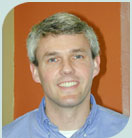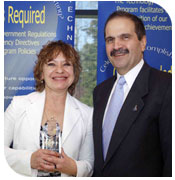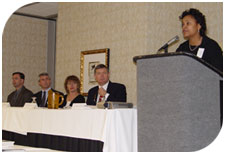 |
| volume 2, number 1 : spring 2004 |
[Download free Acrobat Reader] |
|||||||||
| Contents: 2004 NTR Program Northeast RTTC Hosts Spin-In Workshops the tech transfer process: Step 4: Partnership/License Agreement researcher profile: Peter J. Shirron events: IPP Takes Four Goddard Innovators to NDES Making Spin-In Connections in Utica, New York Wallops Joins in Lower Shore Technology Showcase Tech Transfer Metrics - January 1 - March 31, 2004 Send Us Your Ideas Submit Your New Technologies |
2004 NTR Program
These words were part of Center Director Al Diaz’s opening remarks to the over 100 attendees of the 2004 New Technology Reporting Program. The annual program, which was held April 16th at the Newton White Mansion in Mitchellville, honors the contributions to technology transfer by Goddard’s innovators. In addition to Mr. Diaz’s remarks concerning the new goals for technology spin-out and spin-in, the program also featured a success story. The Hierarchical Segmentation (HSEG) Software, developed by James C. Tilton (Code 935), is being used by multiple NASA programs as well as in industry and academia, making it a spin-in and spin-out success. Bartron Medical Imaging used HSEG and other NASA technology to manufacture Med-Seg, a device for analyzing medical X-rays. Med-Seg will be used by researchers at the School of Dental Medicine at the University of Connecticut. (More information on this success story will appear in an upcoming issue of Goddard Tech Transfer News.) Kerley AwardMr. Diaz also presented the Kerley Award to Jeannette B. Benavides (Code 562) for her outstanding efforts to help transfer her manufacturing process for single-walled carbon nanotubes. James Kerley committed 32 years of his career to Goddard and was a champion of tech transfer for the good of mankind. When Dr. Kerley died in 1994, the Innovative Partnerships Program (IPP) Office created this award to honor his memory. Dr. Benavides is the 10th recipient of the Kerley Award. Patent AwardsPatent counsel Bryan Geurts presented $500 to $1,000 awards to the following inventors for patents issued in 2003:
|
|||||||||
Northeast RTTC Hosts Spin-In Workshops
To facilitate such arrangements, NASA’s Northeast Regional Technology Transfer Center (RTTC), the Center for Technology Commercialization, organized two Joint Venture Opportunity Workshops. At these workshops, Goddard’s senior technologists provided an overview of the Center’s many programs and technology needs. After these presentations, attendees could meet individually with Goddard staff to explore possible partnering opportunities. The first meeting was held in Boston in February. Presenters included Ron Polidan (Goddard’s former chief technologist), Neil Dennehy (Code 890), Michael Johnson (Code 560), Dan Powell (Code 542), Juan Roman (Code 600), Peter Shu (Code 553), Ted Swanson (Code 540), and Stephen Talabac (Code 586). In April, another workshop was held in Rochester, New York. Presenters at this workshop included Jeannette Benavides (Code 562), David Content (Code 551), John Kolasinski (Code 565), Michael Ryschkewitsch (Code 500), Peter Shirron (Code 552), and Carl Stahle (Code 553). “As a networking opportunity, meetings like this are very important,” explained Ms. Cheeks. “Of the 87 attendees at the Rochester event, we had one-on-one meetings with 28 individuals. That’s a great response rate.” |
||||||||||
|
|
||||||||||
Once an interested partner/licensee has proposed a plan for spinning out a Goddard technology, the Innovative Partnerships Program (IPP) Office begins to negotiate the final agreement. |
 |
Note: This series is examining the steps associated with spin-out of a Goddard innovation to a non-NASA application. Future issues of Goddard Tech Transfer News will explore the technology spin-in process.
How does IPP conduct negotiations?
Because the final agreement must be acceptable to and benefit both NASA and the partner, IPP takes a collaborative rather than adversarial approach to negotiations. When the interested partner/licensee submits a project or transfer plan, the IPP considers the proposed terms carefully. If the terms are not acceptable, IPP will not simply shut down the process. Rather, we will communicate as openly as is prudent with the interested party, explaining NASA’s position and seeking a middle ground.
As the inventor, am I involved in negotiations?
Because negotiations can be time-consuming, IPP tries to call upon the inventor as little as possible. However, in some cases, the terms being negotiated relate to technical assistance. Obviously, in these instances, IPP will need to contact you about your availability and willingness to participate.
What kinds of agreements does Goddard use to spinout technology?
The legal agreement used depends upon the individual situation. A Space Act Agreement (SAA) is used when a technology is not easily transferred to the non-NASA application and joint development work is needed, while a license can be used when a transfer is more straightforward. Within these two categories, the following agreements might be used:
- Nonreimbursable SAA-NASA and the partner both contribute resources and/or technology; research must be relevant to a NASA mission or program. Data/Results usually are shared between the two parties.
- Reimbursable SAA-Partner uses NASA resources and agrees to reimburse NASA for the use of its facilities, personnel, and equipment; research should be relevant to NASA.
- Exclusive patent license-The right to be the only organization (other than the U.S. government) allowed to manufacture or use NASA technology.
- Partially exclusive patent license-Exclusive rights are limited to a particular application area, geographic region, or other stipulation.
- Nonexclusive patent license-The right to be one of multiple partners allowed to manufacture or use NASA technology.
Is Goddard interested in only agreements with a high financial gain?
Absolutely not. Although a favorable financial agreement benefits NASA, the Agency recognizes that improvements in health care, quality of life, and scientific advancement are important benefits that can result from tech transfer. NASA’s goal- and consequently OTT’s mission-is to find agreements that yield new applications with recognizable benefits.
Next issue - Step 5: Technology Application and Success Promotion

researcher profile:
Peter J. Shirron
 |
Code 552 Education:
Born: Washington, DC |
What invention are you currently working to transfer?
IPP is helping me transfer several technologies related to an adiabatic demagnetization refrigerator (ADR). Michael DiPirro and I have developed a continuous-duty, multistage ADR for cooling detectors and telescopes to 50 milliKelvin or lower.
What has IPP done to introduce your invention to new users?
IPP provided supplemental funding for our ADR development through the Commercial Technology Development Program, which allowed us to build a prototype ADR. IPP also provided opportunities for locating commercial partners through SAMPE conferences (2003 and 2004) and a workshop in Rochester.
What do you see as the future for your technology?
There is a growing need for this technology within NASA, given that most new astronomy sensors operate at a very low temperature. But an even greater need for low-temperature coolers is in laboratory settings. Two companies are interested in marketing this technology, which might eventually expand the use of low-temperature detectors into such areas as nondestructive evaluation, medical diagnostics, and even quantum computing.
Any advice for your colleagues?
Always check with IPP about the intellectual property (IP) protection status of your technology before presenting it in papers or at conferences. If IP protection is lost, companies tend to be less interested in the technology and it’s harder for Goddard and NASA-and the public-to benefit. Furthermore, spin-out arrangements often lead to spin-in partnerships that can benefit your research later.

Events
IPP Takes Four Goddard Innovators to NDES
|
|
- David Whiteman’s (Code 912) laser power stabilization feedback system
- Michael Hinchey’s (Code 581) specifications and code derivation technology
- John Vranish’s (Code 544) gear bearings, rapid prototypes, and steel bearings
- Michael Beamesderfer’s (Code 541) parylene thickness sensor
In addition, J. Victor Lebacqz, NASA’s Associate Administrator for Aerospace Technology, spoke on the R&D issues confronting the nation in aeronautics and space in the 21st century. He also gave an overview of NASA’s Innovative Technology Transfer Partnerships Program.
As a result of all of these efforts, IPP staff made contact with 11 companies interested in partnering with Goddard. Follow-up efforts are underway.
Making Spin-In Connections in Utica, New York
|
|
Events such as this-and the RTTC workshops-achieve two goals. First, they teach companies and universities about working with NASA in an effort to build regional economic development. Second, they help identify new sources for technology and expertise that complement the skills available at Goddard (i.e., spin-in partnerships).
At the SUNY-IT event, OTT’s Chief Nona Cheeks and researcher John Kolasinski Code 565) participated in a panel discussion of NASA’s future technology needs. The discussion proved valuable for the participants and the presenters, as many attendees stayed on to participate in one-on-one discussions with the NASA representatives. Between this event and the two spin-in workshops, the IPP has identified 20 companies with technologies of interest to Goddard.
Wallops Joins in Lower Shore Technology Showcase
On March 23, researchers from Wallops Flight Facility and Goddard IPP staff joined nearly 175 attendees at "Technology Applications for the Business Community: Biological, Environmental and Space Science," a technology partnering showcase held at Salisbury University. Organized by the Maryland Technology Development Corp., the event sought to bring commercially viable technologies in front of the regional business community for possible marketplace applications. Other labs participating in the event included USDA’s Beltsville Agricultural Research Center and three universities.
Wallops researchers focused on the facilities and flight platforms available to organizations outside of NASA. As explained by Keith Koehler of the Wallops Public Affairs Office in an article published in Delmarva Business Weekly, “Our balloons, rockets, launch range, airport, calibration facilities may not be commercially available locally, or in most cases nationally, for testing instruments with aerospace applications.” Therefore, having access to these nearby facilities gives eastern shore businesses a head start.
Researchers from Wallops with presentations or posters included Wayne Powell (Code 502), Philip Ward (Code 598), and Bruce Underwood (Code 802) as well as contractors Tom Connolly, Glenn Maxfield, Charles Lankford, and Harold Cherrix. Goddard’s IPP staff also were on hand to establish contact with potential partners and licensees. In fact, three tech transfer leads are being pursued.

Tech Transfer Metrics
January 1 to March 31, 2004
New technologies reported: 33
New technologies were reported by the following civil servants, contractors, and universities:
Civil Servants
|
Contractors:ADVR Universities:Carnegie Mellon University |
Licenses/Partnerships: 2
|
|
Patent Applications Filed: 4
|
|
|
Provision Patents Filed: 6
|
|

Send Us Your Ideas
We want to do all we can to make it easy and rewarding for you to participate in the Technology Transfer Program. But we need your help. Send us your ideas for program improvements or News articles via email.
![]()

Submit Your New Technologies
You can report new project technologies by submitting the online form on eNTRe.

A publication of
Innovative Partnerships Program Office
Mailstop 504
Building 22, Room 290
(301) 286-5810
techtransfer@gsfc.nasa.gov



